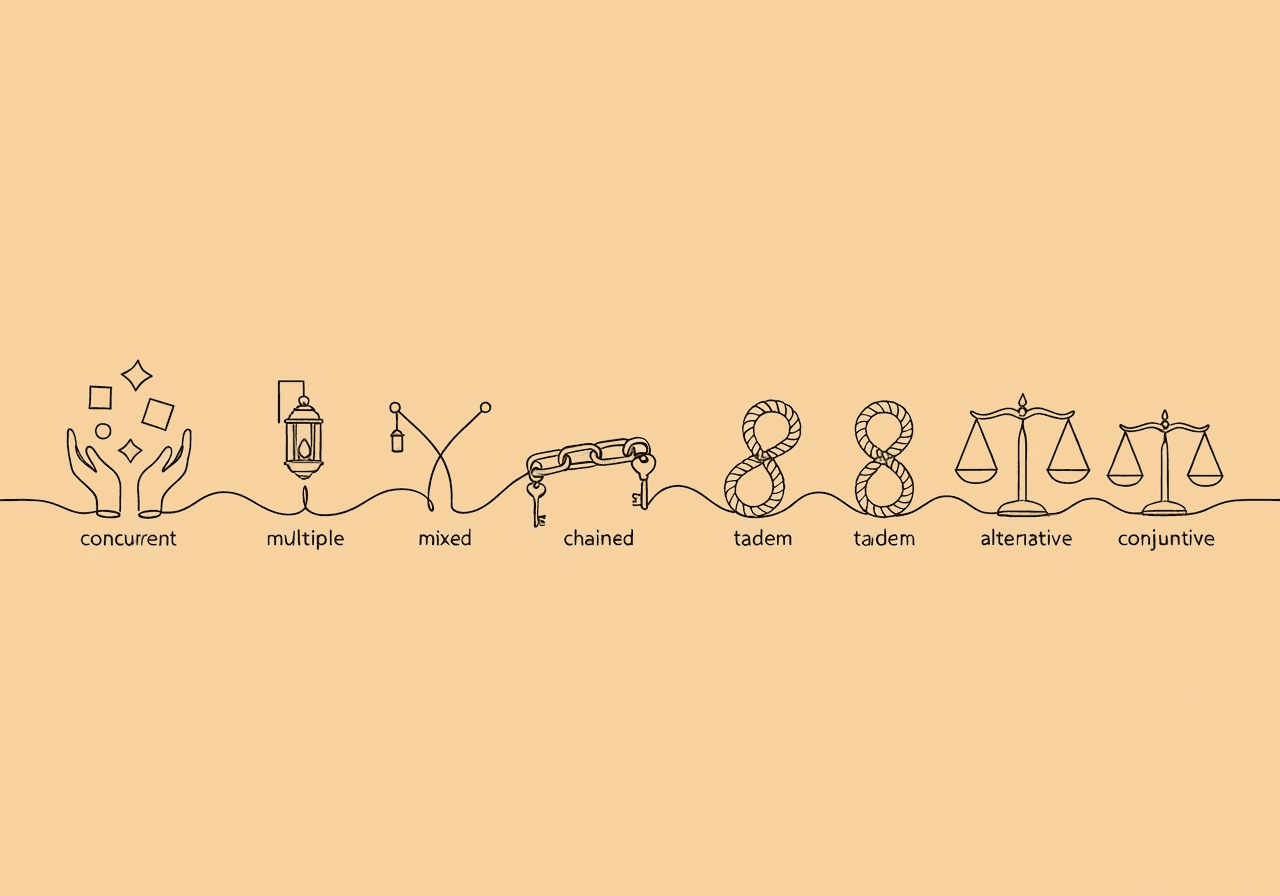Compound Schedules of Reinforcement: BCBA Exam Guide

Applied behavior analysis (ABA) demands a strong command of compound schedules of reinforcement to build effective interventions. These schedules blend basic contingencies like fixed-ratio (FR), variable-ratio (VR), fixed-interval (FI), or variable-interval (VI), fostering behaviors under stimulus control and aligning with principles like the matching law. For BCBAs working with clients facing autism or developmental challenges, they promote generalization and engagement in real-world settings.
Here are key takeaways to guide your practice:
- Compound schedules combine multiple contingencies for complex behavior shaping.
- Discriminative stimuli (SDs) signal reinforcement, aiding precise responding.
- Distinctions like chained vs tandem influence teaching sequences and independence.
- Proper documentation ensures fidelity and compliance with BACB standards.
- Exam prep focuses on identifying types under Task List B-10.
The Seven Compound Schedules of Reinforcement
Consider how concurrent schedules let a child pick between toy play on an FR basis or puzzle time on an FI—choices that mirror daily decisions. This setup runs multiple schedules at once for different behaviors, tying into the matching law where responses match reinforcement rates Behavior Analyst Study.
Multiple schedules switch basic contingencies for behaviors, using distinct SDs like colored cards to signal an FR or VI phase. These cues clarify shifts in reinforcement, helping transition skills across contexts.
What if changes happen without warning? Mixed schedules alternate contingencies like multiple ones but skip SDs, building adaptability through unsignaled shifts—think varying task times without hints descriptive anchor for mixed schedules.
Chained schedules link two or more basic ones in a fixed order. Each step ends with reinforcement and an SD for the next, requiring full completion for the final reward—perfect for routines like dressing (Cooper, Heron, & Heward, chapter on schedules).
Tandem schedules demand the same sequence as chained but without SDs. Learners push through based on prior steps alone, boosting persistence without cues (Cooper, Heron, & Heward, chapter on schedules).
Alternative schedules deliver reinforcement when any one requirement meets first, like an "or" rule—praise after 10 responses or 5 minutes engaged, whichever hits sooner. This flexibility suits fast-paced therapy (Cooper, Heron, & Heward, chapter on schedules).
Finally, conjunctive schedules require all contingencies at once, an "and" setup. Meet a response count plus time interval for reward, ensuring full effort ABA Study Guide.
These types, rooted in ABA foundations, help BCBAs spot nuances in BCBA exam schedules.
The Role of Discriminative Stimuli and Sequence Requirements
SDs cue when reinforcement is available, key for stimulus control in schedules like multiple or chained. Lights or prompts link to components, cutting confusion and sharpening responses. Lacking SDs in mixed or tandem builds context reliance, tough but resilience-building.
Sequences tie behaviors in chained and tandem setups. Chained uses SDs for guided steps, each outcome prompting the next to lock in the chain. Tandem skips cues, demanding self-driven progress—vital for fading prompts toward independence descriptive anchor for concurrent schedules.
BCBAs balance SDs to avoid dependency, matching sequences to goals. Check our RBT C-3: Master Contingencies of Reinforcement Guide for more on basics.
Chained vs. Tandem: A Critical Distinction for BCBA Practice
Why separate chained vs tandem in BCBA exam schedules? Both sequence contingencies, but chained adds SDs per link—each completion reinforces and signals ahead, yielding terminal reward after all. Icons guide dressing steps, say.
Tandem enforces order without signals, merging steps so progress flows from history alone. No cues mean slower starts but better generalization, like task chaining sans visuals descriptive anchor for chained vs tandem.
Pick chained for clear guidance, tandem for self-reliance. It affects data tracking—see our Choosing ABA Measurement Procedures.
Comparison Table: Highlighting Key Differences
This table contrasts the schedules on operation type, SD use, and logic, with ABA examples for quick scans.
| Schedule Type | Simultaneous or Sequential | Discriminative Stimuli (SD) | Contingency Logic (Either/Or vs. All) | Example Application in ABA |
|---|---|---|---|---|
| Concurrent | Simultaneous (behavior choices) | Yes (per option) | Either (select one) | Task selection with rate differences descriptive anchor for compound glossary |
| Multiple | Sequential (phased alternations) | Yes (phase signals) | Either (active phase) | Color cues for FR or VI shifts in lessons |
| Mixed | Sequential (phased alternations) | No | Either (active phase) | Surprise changes in activity durations |
| Chained | Sequential (ordered links) | Yes (link cues) | All (complete chain) | Cued steps in hygiene routines |
| Tandem | Sequential (ordered links) | No | All (complete sequence) | Seamless progress in skill building |
| Alternative | Simultaneous or sequential | Optional | Either (first criterion) | Reward on responses or time, whichever first |
| Conjunctive | Simultaneous or sequential | Optional | All (all criteria) | Quota plus interval for full engagement descriptive anchor for compound exploration |
SDs and sequences customize fits for therapy aims, easing documentation reference.
Implications for BCBA Clinical Documentation and Treatment Design
Compound schedules of reinforcement require detailed notes on type, SDs, sequences, and data like IOA for chained work. This tracks fidelity per Ethics Code for Behavior Analysts and meets HIPAA rules for health info HIPAA Privacy Rule guidance. Such records justify tweaks and uphold ethics.
In design, they add real-life variability—concurrent for choices, conjunctive for mastery. Fade mismatched SDs to boost generalization. Avoid pitfalls with our BCBA IOA Documentation Mistakes guide. They drive lasting change through tailored plans descriptive anchor for multiple schedules.
Frequently Asked Questions
How do concurrent schedules differ from multiple and mixed schedules?
Concurrent schedules offer simultaneous options for behaviors, enabling choice per the matching law—responses match rates. Multiple alternate for one behavior with SD signals per phase for control. Mixed alternate without signals, training adaptation to surprises descriptive anchor for compound schedules.
What are the key differences between chained and tandem schedules?
Chained sequences use SDs to cue each step, reinforcing links toward full-chain terminal reward—ideal for guided routines. Tandem sequences lack SDs, relying on cumulative progress for the same order—better for independence descriptive anchor for chained vs tandem.
How do discriminative stimuli enhance compound schedules in ABA?
SDs cue availability, building control for accurate responses in multiple or chained types. They speed learning and fade to natural cues for generalization. No-SD types like mixed foster flexibility despite early errors descriptive anchor for concurrent schedules.
Can you provide examples of alternative and conjunctive schedules in therapy?
Alternative reinforces the first met rule, like praise after 10 responses or 5 minutes—boosting efficiency. Conjunctive needs all, such as quota and time—ensuring thoroughness. Document clearly for both descriptive anchor for compound glossary.
How do compound schedules relate to BCBA exam preparation?
BCBA exam schedules cover types under Task List B-10, testing definitions, SD roles, and chained vs tandem. Practice spotting concurrent for choices or mixed for unsignaled shifts to build ethical plans BCBA Test Content Outline.
What role do compound schedules play in clinical treatment design?
They blend contingencies for client fit, like chained routines or concurrent preferences, to lift engagement and generalization. Note details for fidelity, data-driven tweaks per BACB norms descriptive anchor for multiple schedules.
Mastering compound schedules of reinforcement lets BCBAs design precise treatments for real progress. Concurrent builds autonomy, chained fosters routines—tools grounded in ABA evidence. They tie to documentation for accountability.
Audit plans for SDs or sequences, check data for fits, and drill BCBA exam schedules on chained vs tandem. Draw from Cooper et al. for depth. This skill sharpens practice and client outcomes.
Popular in Study Guides & Exam Prep
- 1
2025 RBT Competency Assessment Preparation Checklist
1,94010 min read - 2
RBT Task List A-01: Prepare for Data Collection — 7-Step Checklist
5966 min read - 3
Essential BCBA Supervision Contract Requirements
5359 min read - 4
RBT Exam Study Guide 2025: Complete Prep with Practice Questions & Tips
4198 min read - 5
ABA Latency, IRT, Duration: RBT Data Collection Guide
4188 min read
Popular in Study Guides & Exam Prep
- 1
2025 RBT Competency Assessment Preparation Checklist
1,94010 min read - 2
RBT Task List A-01: Prepare for Data Collection — 7-Step Checklist
5966 min read - 3
Essential BCBA Supervision Contract Requirements
5359 min read - 4
RBT Exam Study Guide 2025: Complete Prep with Practice Questions & Tips
4198 min read - 5
ABA Latency, IRT, Duration: RBT Data Collection Guide
4188 min read
Related Resources
Explore more helpful content on similar topics

BCBA Visual Analysis of Data: Exam Prep Essentials
Master BCBA visual analysis of data essentials for your exam. Discover how to interpret level, trend, and variability in ABA for functional relations. Ace your BCBA test with expert tips!

Philosophical Assumptions of ABA: Essential Guide for BCBAs
Explore philosophical assumptions of ABA essential for BCBAs. Discover determinism, empiricism, experimentation, replication, parsimony, and philosophic doubt with practical examples and a summary table.

Alternating Treatments Design BCBA: Exam Essentials
Ace your BCBA exam with this essential guide to Alternating Treatments Design BCBA. Discover setup steps, Multielement Design basics, ATD data interpretation, and compliance strategies for effective ABA practice.